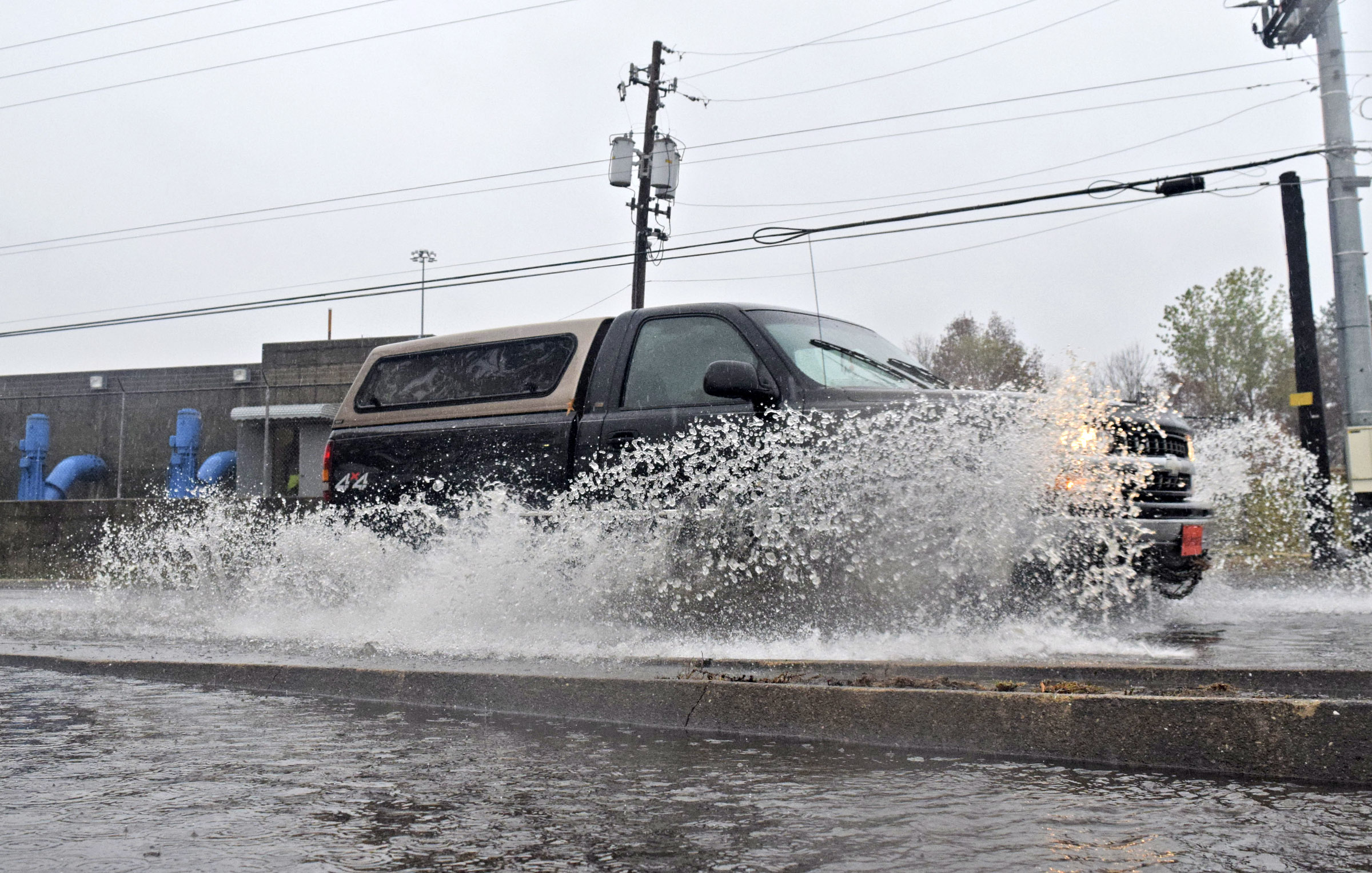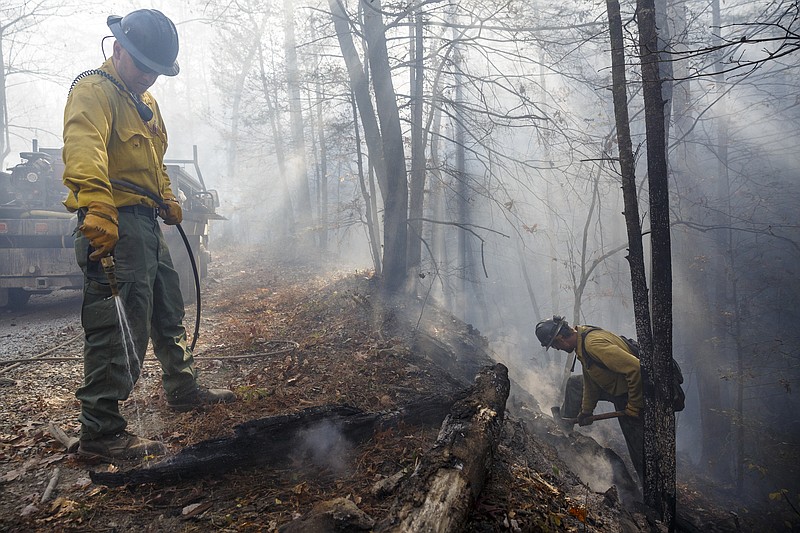 A truck drives through high water on Cornelison Road near Eastgate Centre in Brainerd. In the background is one of the pumpstations that manages flooding along the Brainerd Levee. Heavy rains caused ponding on roads in the Chattanooga area on November 30, 2016.
A truck drives through high water on Cornelison Road near Eastgate Centre in Brainerd. In the background is one of the pumpstations that manages flooding along the Brainerd Levee. Heavy rains caused ponding on roads in the Chattanooga area on November 30, 2016.
Wildfires ravage Southeast
- Two juveniles arrested, charged in deadly Gatlinburg wildfires
- Tennessee takes four area counties off burn ban list to aid tornado cleanup
- Rain helps with area wildfires, but Tennessee burn ban remains [videos, photos]
- Gatlinburg wildfires death toll climbs to 14; officials estimate 1,684 structures damaged or destroyed
- Nonprofits and state agencies step up relief efforts amid tornado, wildfire damage
- Man charged for allegedly intentionally setting a Sequatchie County wildfire
- Rain brings relief for wildfires
- Southern storms should ease drought, but fire threat remains
- At long last, substantial rain is expected throughout Chattanooga area
- Gov. Bill Haslam applauds wildfire fighters' efforts
- Firefighters make progress in Southeast wildfires, but threat remains
- Crews fighting large fire in northeast Alabama
- Gov. Haslam vows to pursue wildfire arsonists 'with everything we have'
- Hamilton County wildfires to cost more than $600,000
- Forestry crews prepared to miss Thanksgiving with families as they battle wildfires
- Wildfires rage on; new one pops up in North Georgia
- Gasp! Wildfires cause hacking and wheezing across the South
- Air quality improves, rain possible this weekend
- Relentless smoke spreads fear at edge of southern wildfires
- Catoosa County issues burn ban
- Many outdoor activities banned as fires burn across south
- Two men charged with arson as crews make progress quelling 3 area blazes
- Chattanooga is on target to break record for driest year in city's history
- Alabama man confesses to starting Sequatchie County fire
- Area wildfires containment increases, Flipper Bend fire 95 percent contained
- Catholic Mass offered for wildfire relief
- Fire crews hope to reach 100 percent containment on 3 area wildfires
- Wildfire smoke engulfs Chattanooga, endangering health of residents
- No rain in forecast as Chattanooga area wildfires continue to burn
- Tennessee Gov. Haslam issues 51-county burning ban
- Firefighters use hand tools to fight Chattanooga-area wildfires with no rain in sight
- Hundreds hospitalized with breathing problems amid Chattanooga-area wildfire outbreak
- Sohn: Might wildfire smoke be harbinger of days to come?
- New fires sprout in Chattanooga area as firefighters work to contain thousands of acres burning across region
- Arson suspected in most Chattanooga area wildfires
- UPDATE: Man arrested after admitting he set three wildfires that consumed 300 acres
- The latest update on the unprecedented fire season in the tri-state area
- Wildfires burning total of 9,680 acres across eastern half of Tennessee; FEMA steps in to offer aid [videos, photo galleries]
- Southern fires rage with 41.6 million now living in drought
- Wildfires continue across region with no rain imminent; some residents evacuated
- Chattanooga area wildfire smoke triggers 'Code Red' air quality alert [videos]
Devastating Gatlinburg fires
- Emergency management officials warn of Sevier County fire recovery scams
- President Obama signs disaster declaration to aid Sevier County
- Gatlinburg firefighting team may head home soon [videos]
- 2016 wildfire season one for the books; officials say it's too soon to say it's over [video]
- Governor seeks quick action on disaster request for Tennessee [photos]
- Did Sevier County's lax building codes help fire spread?
- Chapel of Love lost to fire that ravaged Gatlinburg
- Card games raise cash for fire victims
- Teens charged in fatal Gatlinburg wildfire were playing with matches
- Tourists stream back to Gatlinburg, but rebuilding looms
- Two juveniles arrested, charged in deadly Gatlinburg wildfires
- Businesses that survived the Gatlinburg wildfire are reopening
- Gatlinburg wildfires death toll climbs to 14; officials estimate 1,684 structures damaged or destroyed
- Officials defend controversial timing of evacuation warnings sent after blaze reached Gatlinburg [videos]
- Cars line up to see wildfire-ravaged Tennessee city; 13 dead
- During first look at wildfire rubble, residents in a daze
- Haslam heading to wildfire-ravaged Gatlinburg today
- Death toll from Tennessee wildfires increases to 13
- Search continues for any survivors of wildfires
- Dollywood Foundation to donate $1,000 per month to fire victims
- More than 70 area firefighters helped fight massive fires in Gatlinburg
- University of Tennessee professor predicted Gatlinburg fire for years
- Chattanooga firefighters drive 150 miles to answer Gatlinburg's call for aid as blaze rages
- Dolly Parton heartbroken by wildfires torching her hometown
- Deadly, destructive wildfires ravage Tennessee tourism town
- Tennessee mayor confirms 3 deaths in wildfires
- Wildfires scorch tourist area in Tennessee; thousands flee
- Video: Two men navigate horrifying Gatlinburg mountain fire
- Rhea County students safe after wildfires force evacuation
- Chattanooga firefighters drive 150 miles to answer Gatlinburg's call for aid as blaze rages
- The Latest: Officials say thousands evacuated, 4 injured
- Gatlinburg aquarium workers worried about animals left behind after wildfire forces evacuation
- Gatlinburg, Tenn., hotels, homes destroyed in fires
- Wildfires lead to evacuation of downtown Gatlinburg, Tenn.
Finally, the parched and burning tri-state region has gotten its first taste of game-changing rain that may put a dent in the many wildfires afflicting it.
A little over a week ago, this year was shaping up to be the driest on record for Chattanooga, but the recent deluge could put the area in a more reasonable range if it continues, as meteorologists suspect it might.
"We've had 5.4 inches in the last 41 hours," said Paul Barys, chief meteorologist for WRCB-TV Channel 3 on Wednesday afternoon. "We've had almost as much rain as we had from July 24 to Nov. 27. It's an enormous change."
According to Barys, the pattern that has plunged portions of Tennessee, Georgia and Alabama into record drought levels is breaking down enough to permit the much-needed rainfall.
In looking ahead to the next week, with occasional showers expected Sunday through Tuesday, he is hoping the good news will continue long enough to help the area begin to dig its way out of the drought.
"We're trying to get out of the driest year in history. If we can break out of this pattern, which we seem to have already, if we get 1 to 3 inches, that will be very helpful," he said.
With the most recent downpour, Chattanooga has received 30.53 inches of rainfall for the year so far, just two inches shy of the total rainfall for the driest year on record, 1904, when the city received 32.68 inches.
Which is not to say the rainfall average will necessarily be close to the yearly average. Only a week ago, Chattanooga sat at 20 inches below its yearly average rainfall. As welcome as the precipitation is, it won't bust the drought overnight.
"Instead of being in first place as far as the driest year, we might be in second place," Barys said.
For the agencies tasked with fighting the dozens of wildfires that have ignited throughout the area, rain is more than just a relief, it's a potential light at the end of a very, very long tunnel.
Jim Dale, Tennessee assistant district forester, said the rain is a necessary factor in finally putting down some of the most persistent wildfires in the area.
"If we can continue to get periodic rains and slowly soak into especially those larger fuels, hopefully before long we'll be in reasonably good shape," Dale said. "Anything substantial is going to eventually soak into the soil enough that we feel like the organic material is not going to be as readily ignitable as it has been."
As of Wednesday afternoon, two of the largest Hamilton County fires, Flipper's Bend and Poe Road, were fully contained, according to the Tennessee Department of Agriculture's website. A third fire, Mowbray Mountain, was 98 percent contained.
The trio has consumed a total of 2,592 acres of land. However, despite the fact that the fires have been contained, winds continue to cause reignitions behind the burn lines.
"It was all contained, but here we are a week from having those fully contained and then we had reignitions because we had a little wind," Dale said.
Officials are still babysitting the fires, but are hopeful the lines will hold with more rain coming up this weekend to further dampen the blazes and their fuel. The worry now is what might happen with falling temperatures that would cut down humidity levels and open another window of opportunity for more fires.
"The low temperature is one thing, but when you have low relative humidity, you can still have some pretty significant wildfire activities," Dale said.
Firefighters will have to wait and see what conditions look like several weeks from now, but for now the rain is a good sign that's being celebrated over the Georgia border as much as it is in Tennessee.
"The rain certainly helped," said Wendy Burnett, spokeswoman for the Georgia Forestry Commission.
She said a pilot got a good look at wildfires her agency is fighting - not including the Rough Ridge fire near Blue Ridge, which is over 27,000 acres and is being handled by federal agencies - and didn't see much smoke at those sites.
But that doesn't mean firefighters are out of the woods. What is needed is for the rain to continue, and continue for a while.
"What we're really going to need is to get into a more consistent pattern of regular rainfall to get us out of the drought and get us out of our fire danger that we've been in," Burnett said.
"If last night was it, yesterday was it, or if we just get a sprinkling tomorrow and that's it, then in a week we could be right back where we were. Things were just so dry that it wouldn't take very long for things to dry right back out," she said.
Contact staff writer Emmett Gienapp at egienapp@timesfreepress.com or 423-757-6731. Follow on Twitter @emmettgienapp.

